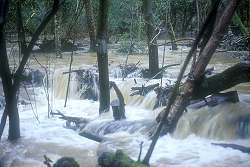Summary

Standing trees, fallen logs, branches and leaf litter form a very dynamic and complex network of multiple channels and dams, which help to slow down flood flows
Although most of Britain’s original floodplain woodland has been lost due to past river engineering and land reclamation works, there is good evidence to suggest that it could have an important role to play in ameliorating downstream flooding. This is based on woodland’s greater hydraulic roughness compared to other vegetation types, which acts to slow down and thus potentially reduce flood peaks.
Unfortunately, floodplain woodlands also pose a number of risks for flood defence. These include enhanced upstream flooding due to the backing-up of floodwaters, restricted access to river banks for flood defence works, loss of engineered flood control, and increased downstream flooding caused by large woody debris blocking bridges and other structures.
A major element of our forest hydrology programme is to evaluate the effects of floodplain and riparian woodlands on flood flows. Studies include:
- Modelling the hydraulic effects of floodplain woodland (PDF-3720K)
- An assessment of the impact of floodplain woodland on flood flows
- Measuring the hydraulic roughness of UK floodplain woodlands
- Measuring the effects of existing floodplain woodland on flood flows
- Identifying opportunities for the planting of floodplain woodland
- Monitoring the effects of the creation of new floodplain woodlands
- Evaluating the effects of riparian woodland and large woody debris dams on flood flows
- Restoring floodplain woodland for flood alleviation (below).
Restoring floodplain woodland for flood alleviation
The final report on this Defra funded project was published in July 2008. The work provides further support for the potential of floodplain woodland to alleviate downstream flooding.
Restoring floodplain woodland for flood alleviation (PDF-1974K)
Unfortunately, it proved not possible to plant floodplain woodland at the selected sites and the project had to be curtailed. Lessons learnt and recommendations for future work are set out, including the need for one or more replacement demonstration sites to be established to communicate and explain the benefits of floodplain woodland for flood alleviation.
